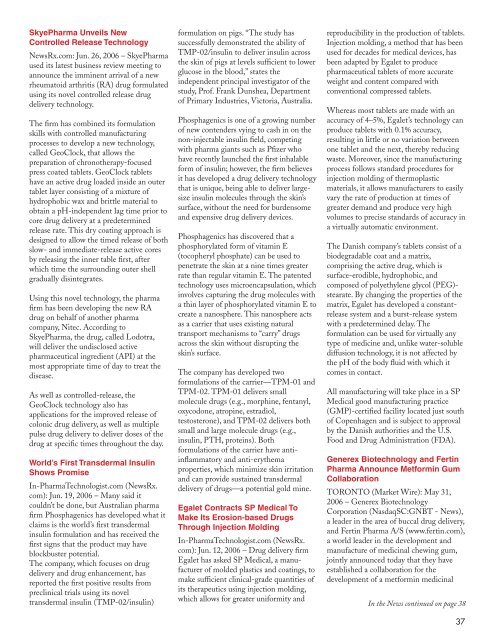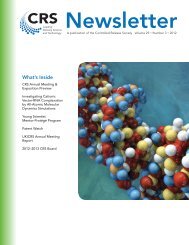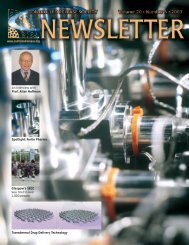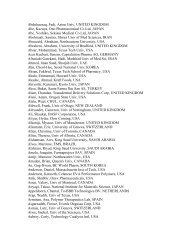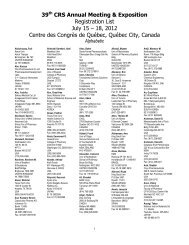CRS Newsletter. Volume 23, Number 3. 2006 - Controlled Release ...
CRS Newsletter. Volume 23, Number 3. 2006 - Controlled Release ...
CRS Newsletter. Volume 23, Number 3. 2006 - Controlled Release ...
You also want an ePaper? Increase the reach of your titles
YUMPU automatically turns print PDFs into web optimized ePapers that Google loves.
SkyePharma Unveils New<br />
<strong>Controlled</strong> <strong>Release</strong> Technology<br />
NewsRx.com: Jun. 26, <strong>2006</strong> – SkyePharma<br />
used its latest business review meeting to<br />
announce the imminent arrival of a new<br />
rheumatoid arthritis (RA) drug formulated<br />
using its novel controlled release drug<br />
delivery technology.<br />
The firm has combined its formulation<br />
skills with controlled manufacturing<br />
processes to develop a new technology,<br />
called GeoClock, that allows the<br />
preparation of chronotherapy-focused<br />
press coated tablets. GeoClock tablets<br />
have an active drug loaded inside an outer<br />
tablet layer consisting of a mixture of<br />
hydrophobic wax and brittle material to<br />
obtain a pH-independent lag time prior to<br />
core drug delivery at a predetermined<br />
release rate. This dry coating approach is<br />
designed to allow the timed release of both<br />
slow- and immediate-release active cores<br />
by releasing the inner table first, after<br />
which time the surrounding outer shell<br />
gradually disintegrates.<br />
Using this novel technology, the pharma<br />
firm has been developing the new RA<br />
drug on behalf of another pharma<br />
company, Nitec. According to<br />
SkyePharma, the drug, called Lodotra,<br />
will deliver the undisclosed active<br />
pharmaceutical ingredient (API) at the<br />
most appropriate time of day to treat the<br />
disease.<br />
As well as controlled-release, the<br />
GeoClock technology also has<br />
applications for the improved release of<br />
colonic drug delivery, as well as multiple<br />
pulse drug delivery to deliver doses of the<br />
drug at specific times throughout the day.<br />
World’s First Transdermal Insulin<br />
Shows Promise<br />
In-PharmaTechnologist.com (NewsRx.<br />
com): Jun. 19, <strong>2006</strong> – Many said it<br />
couldn’t be done, but Australian pharma<br />
firm Phosphagenics has developed what it<br />
claims is the world’s first transdermal<br />
insulin formulation and has received the<br />
first signs that the product may have<br />
blockbuster potential.<br />
The company, which focuses on drug<br />
delivery and drug enhancement, has<br />
reported the first positive results from<br />
preclinical trials using its novel<br />
transdermal insulin (TMP-02/insulin)<br />
formulation on pigs. “The study has<br />
successfully demonstrated the ability of<br />
TMP-02/insulin to deliver insulin across<br />
the skin of pigs at levels sufficient to lower<br />
glucose in the blood,” states the<br />
independent principal investigator of the<br />
study, Prof. Frank Dunshea, Department<br />
of Primary Industries, Victoria, Australia.<br />
Phosphagenics is one of a growing number<br />
of new contenders vying to cash in on the<br />
non-injectable insulin field, competing<br />
with pharma giants such as Pfizer who<br />
have recently launched the first inhalable<br />
form of insulin; however, the firm believes<br />
it has developed a drug delivery technology<br />
that is unique, being able to deliver largesize<br />
insulin molecules through the skin’s<br />
surface, without the need for burdensome<br />
and expensive drug delivery devices.<br />
Phosphagenics has discovered that a<br />
phosphorylated form of vitamin E<br />
(tocopheryl phosphate) can be used to<br />
penetrate the skin at a nine times greater<br />
rate than regular vitamin E. The patented<br />
technology uses microencapsulation, which<br />
involves capturing the drug molecules with<br />
a thin layer of phosphorylated vitamin E to<br />
create a nanosphere. This nanosphere acts<br />
as a carrier that uses existing natural<br />
transport mechanisms to “carry” drugs<br />
across the skin without disrupting the<br />
skin’s surface.<br />
The company has developed two<br />
formulations of the carrier—TPM-01 and<br />
TPM-02. TPM-01 delivers small<br />
molecule drugs (e.g., morphine, fentanyl,<br />
oxycodone, atropine, estradiol,<br />
testosterone), and TPM-02 delivers both<br />
small and large molecule drugs (e.g.,<br />
insulin, PTH, proteins). Both<br />
formulations of the carrier have antiinflammatory<br />
and anti-erythema<br />
properties, which minimize skin irritation<br />
and can provide sustained transdermal<br />
delivery of drugs—a potential gold mine.<br />
Egalet Contracts SP Medical To<br />
Make Its Erosion-based Drugs<br />
Through Injection Molding<br />
In-PharmaTechnologist.com (NewsRx.<br />
com): Jun. 12, <strong>2006</strong> – Drug delivery firm<br />
Egalet has asked SP Medical, a manufacturer<br />
of molded plastics and coatings, to<br />
make sufficient clinical-grade quantities of<br />
its therapeutics using injection molding,<br />
which allows for greater uniformity and<br />
reproducibility in the production of tablets.<br />
Injection molding, a method that has been<br />
used for decades for medical devices, has<br />
been adapted by Egalet to produce<br />
pharmaceutical tablets of more accurate<br />
weight and content compared with<br />
conventional compressed tablets.<br />
Whereas most tablets are made with an<br />
accuracy of 4–5%, Egalet’s technology can<br />
produce tablets with 0.1% accuracy,<br />
resulting in little or no variation between<br />
one tablet and the next, thereby reducing<br />
waste. Moreover, since the manufacturing<br />
process follows standard procedures for<br />
injection molding of thermoplastic<br />
materials, it allows manufacturers to easily<br />
vary the rate of production at times of<br />
greater demand and produce very high<br />
volumes to precise standards of accuracy in<br />
a virtually automatic environment.<br />
The Danish company’s tablets consist of a<br />
biodegradable coat and a matrix,<br />
comprising the active drug, which is<br />
surface-erodible, hydrophobic, and<br />
composed of polyethylene glycol (PEG)stearate.<br />
By changing the properties of the<br />
matrix, Egalet has developed a constantrelease<br />
system and a burst-release system<br />
with a predetermined delay. The<br />
formulation can be used for virtually any<br />
type of medicine and, unlike water-soluble<br />
diffusion technology, it is not affected by<br />
the pH of the body fluid with which it<br />
comes in contact.<br />
All manufacturing will take place in a SP<br />
Medical good manufacturing practice<br />
(GMP)-certified facility located just south<br />
of Copenhagen and is subject to approval<br />
by the Danish authorities and the U.S.<br />
Food and Drug Administration (FDA).<br />
Generex Biotechnology and Fertin<br />
Pharma Announce Metformin Gum<br />
Collaboration<br />
TORONTO (Market Wire): May 31,<br />
<strong>2006</strong> – Generex Biotechnology<br />
Corporation (NasdaqSC:GNBT - News),<br />
a leader in the area of buccal drug delivery,<br />
and Fertin Pharma A/S (www.fertin.com),<br />
a world leader in the development and<br />
manufacture of medicinal chewing gum,<br />
jointly announced today that they have<br />
established a collaboration for the<br />
development of a metformin medicinal<br />
In the News continued on page 38


